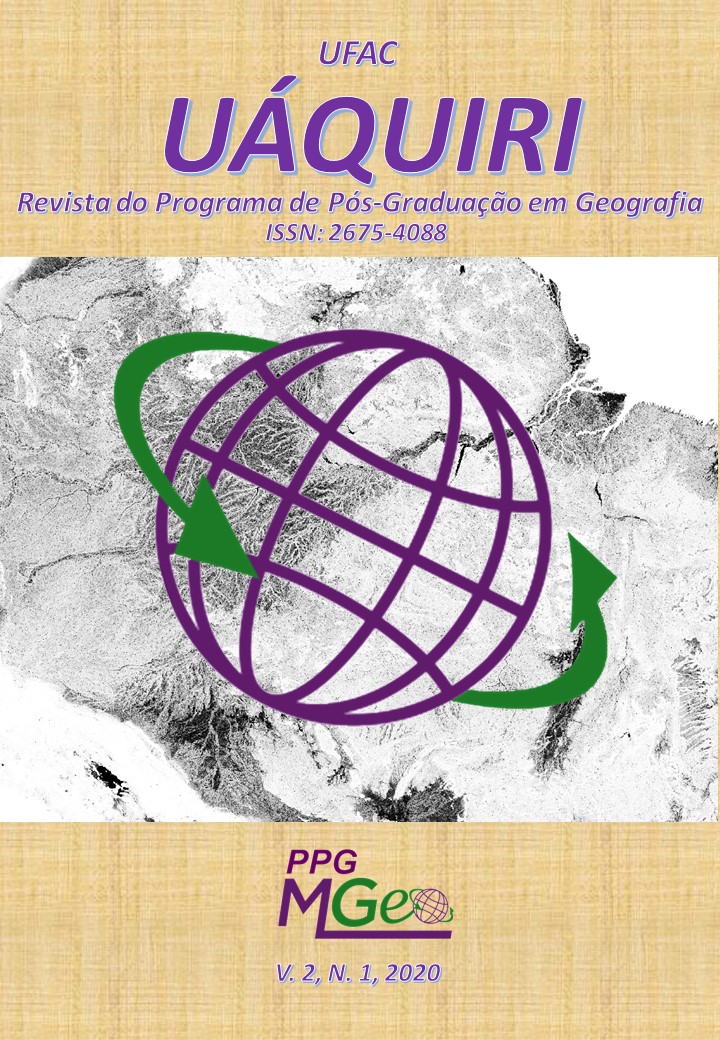O USO DE GEOPORTAIS BASEADOS EM SIG DURANTE A PANDEMIA DE CORONAVIRUS (COVID-19), COMO FERRAMENTA DE ACESSO ABERTO, DESTINADA AO CONTROLE E À TOMADA DE DECISÕES.
DOI:
https://doi.org/10.47418/uaquiri.vol2.n1.2020.3646Palavras-chave:
geografia dos riscos, síndrome respiratória, SARS-Co-V2Resumo
Em dezembro de 2019, diversos casos de uma síndrome respiratória aguda grave foram relatados na província de Hubei, Wuhan, China, com rápida transmissão para outras partes da Ásia e do mundo. Essa doença é conhecida como Covid-19 e apresenta impacto socioeconômicos ainda incalculáveis. A atual capacidade de atualização das informações em tempo real ao redor do mundo, permitiu a espacialização dos casos da doença e avaliação do risco de contágio, permitido uma rápida resposta dos órgãos governamentais. Dessa forma, este artigo apresenta uma serie de plataformas, baseadas em sistemas de informações geográficas (SIG), destinados ao mapeamento da pandemia de coronavírus. Por fim, concluiu-se que os métodos de espacialização se tornaram essenciais para fomentar, planejar e tomar decisão, no combate a uma pandemia. Além disso, tais plataformas, popularizaram o acesso a informação, através do compartilhamento dinâmico da ocorrência do covid-19 pelo mundo.
Referências
BOGOCH I. I.; WATTS, A.; THOMAS-BACHLI, A.; HUBER, C.; KRAEMER, M. U. G.; KHAN, K. Pneumonia of unknown etiology in Wuhan, China: potential for international spread via commercial air travel. J Travel Med, p. 1-3, 2020. DOI: https://doi.org/10.1093/jtm /taaa008.
BOULOS, M. N. K AND GERAGHTY, E. M. Geographical tracking and mapping of coronavirus disease COVID‑19/severe acute respiratory syndrome coronavirus 2 (SARS‑CoV‑2) epidemic and associated events around the world: how 21st century GIS technologies are supporting the global fight against outbreaks and epidemics. International Journal of Health Geographics, v. 18, n. 19, p. 1-18, 2020. DOI: https://doi.org/10.1186/s12942-020-00202-8
BROWNSTEIN, J.S.; FREIFELD, C.; MADOFF, L.C. Digital Disease Detection - Harnessing the Web for Public Health Surveillance. N. Engl. J. Med, n. 360, p. 2153–2157, 2009. DOI: https://doi.org/10.1056/NEJMp0900702.
CHINESE CENTER FOR DISEASE CONTROL AND PREVENTION (CCDC). The Epidemiological Characteristics of an Outbreak of 2019 Novel Coronavirus Diseases (COVID-19)–China. 2020. Disponível em: <http://weekly.chinacdc.cn/en/article/id/e53946e2-c6c4-41e9-9a9b-fea8db1a8f51>. Acessado em: 13/04/2020.
GARDNER L. Mapping 2019-nCoV. Johns Hopkins, 2020. 1disponivel em: < <https://systems.jhu.edu/research/public-health/ncov/> Acessado em 03/05/2020.
JOHNS HOPKINS (CSSE). Corona Virus 2019-nCoV Cases (The Living Atlas), 2020. Disponível em: <https://livingatlas.arcgis.com/en/browse/#d=2&q=%22Corona%20Virus%202019%20nCoV%20Cases%22.> Acessado em 03/05/2020.
KOCH, T. Mapping the Miasma: Air, Health, and Place in Early Medical Mapping. cartographic perspectives, n. 25, p. 4-27, 2005. DOI: https://doi.org/10.14714/CP52.376
Microsoft, Microsoft Big Maps e MapPoit Web Service. Rastreador COVID-19, 2020. Disponível em: < https://www.bing.com/covid>, acessado em 26/04/2020.
MINISTÉRIO DA SAÚDE (MS. Brasil). Covid Radar: Todos juntos contra a covid-19. Coletivo de mais de 40 organizações, 2020. Disponível em: <https://www.covidradar.org.br/>, acessado em 01/05/2020.
PAN AMERICAN HEALTH ORGANIZATION (PAHOa). Cumulative COVID-19 cases reported by countries and territories in the Americas, 2020. Disponível em: <https://who.maps.arcgis.com/apps/webappviewer/index.html?id=2203b04c3a5f486685a15482a0d97a87&extent=-20656313.6818%2C-3596894.4332%2C1611932.8945%2C7390469.7606%2C102100&site=paho>. Acessado em: 15/04/2020.
PAN AMERICAN HEALTH ORGANIZATION (PAHOb). COVID-19 Situation in the Region of the Americas. Situation as of 14 April 2020 (14:00 EST). Disponivel em: <https://www.paho.org/en/topics/coronavirus-infections/coronavirus-disease-covid-19>. Acessado em: 15/04/2020.
WORLD HEALTH ORGANIZATION (WHO/OMS). Statement on the second meeting of the International Health Regulations Emergency Committee regarding the outbreak of novel coronavirus (2019-nCoV), 2020. Disponível em < https://www.who.int/news-room/detail/30-01-2020-statement-on-the-second-meeting-of-the-international-health-regulations-(2005)-emergency-committee-regarding-the-outbreak-of-novel-coronavirus-(2019-ncov)> Acessado em: 03/05/2020.
XU, B.; KRAEMER M. U. G. Open access epidemiological data from COVID-19 outbreak. The Lancet: Infectious Diseases, Published: February 19, 2020. DOI: https://doi.org/10.1016/S1473-3099(20)30119-5
ZHAO, S.; LIN, Q.; RAN, J.; MUSA, S. S.; YANG, G.; WANG, W.; LOU, Y.; GAO, D.; YANG, L.; HE, D.; WANG, M. H. Preliminary estimation of the basic reproduction number of novel coronavirus (2019-nCoV) in China, from 2019 to 2020: A data-driven analysis in the early phase of the outbreak. International Journal of Infectious Diseases, n. 92, p. 214-217, 2020. DOI: https://doi.org/10.1016/j.ijid.2020.01.050
Downloads
Publicado
Versões
- 2021-08-24 (2)
- 2020-05-19 (1)










